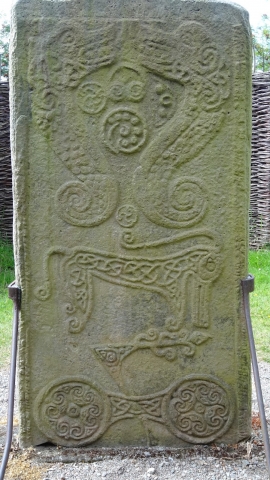Rodney's Stone - Pictish 8th century standing stone in Scotland

Rodney's Stone is a two-metre (6.56 ft) high Pictish cross slab. It is now located close on the approach way to Brodie Castle, near Forres, Moray, Scotland. (Scottish Gaelic: Farrais, Moireibh, Alba). It was discovered in the late 18th Century during excavations for the foundation of the new parish church at Dyke. The church, built in 1781, stands on the site of an earlier mediaeval church.
The Class II Pictish symbol stone is made of grey sandstone. The front bears a cross with interlacing design, with symbols in the four cut-out quadrants surrounding the cross. The reverse bears two sea creatures along with an elephant and a double-disc and Z-rod below them. All of the symbols are in relief. A number of Pictish stones have survived and are thought to date from the 6th to 9th century. The Picts were a Celtic-speaking peoples who lived in what is today eastern and northern Scotland.
Rodney's Stone is notable for its Ogham carved inscription on the side angles, the longest such inscription known in Scotland. Ogham is an alphabet used primarily to write the very early Irish language. This is the language that is the ancestor to Old Irish, which in turn is ancestor of all three contemporary Gaelic languages (Irish, Manx, and Scottish Gaelic). The Rodney Stone also has carved on it the Pictish name Ethernan (a prominent Pictish saint), written as "EDDARRNON".
The earliest inscriptions in ogham have been thought to date to about the 4th century AD, although many believe them to be much earlier in origin. Examples of ogham inscriptions can be found in a number of the Celtic countries: Ireland (Éire) Scotland (Alba), Isle of Man (Mannin), Wales (Cymru) and also in Cornwall (Kernow).





